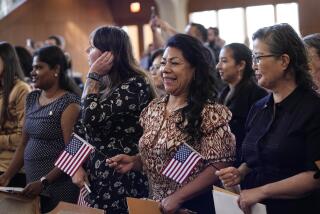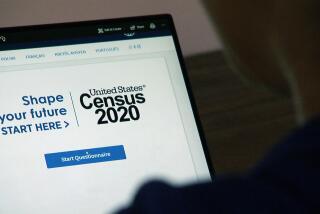Op-Ed: The Census Bureau undercounts Latinos. It’ll take more than technology to fix that
A new report issued last week by Child Trends, a research organization, and the National Assn. of Latino Elected and Appointed Officials Educational Fund calculated that the 2010 census missed some 400,000 young Latino children — the equivalent of more than half a congressional district. The data — a comparison of census records with county birth, death and immigration records — indicate that the 2010 undercount rate for young Latinos was 7.1%, compared to 4.3% for non-Latinos. The shortfall was pronounced in specific counties in five states: California, Texas, Arizona, Florida and New York.
California accounted for more than a quarter of young Latino children who were not counted. An estimated 47,000 Latino children under age 5 were missed in Los Angeles County alone, by far the biggest undercount of any county in the United States.
U.S. Census Bureau data are used to allocate more than $400 billion in federal funds to states and counties for transportation, public health, early childhood programs and other essential services. And young Latino children — who represent one-quarter of all U.S. children under 5, and whose numbers are growing — need these services most of all, since nearly two-thirds of them live in or near poverty. The census count also determines each state’s congressional representation. An accurate census is essential to the fair distribution of national resources, and to the very life of our democracy.
The Census Bureau does an important job of counting the country’s residents every 10 years and paints a generally accurate picture of the total population. The next census, in 2020, will be the first to count people online, but technology alone can’t fix the particular undercount of Latino children. The bureau must take additional steps to ensure a complete count and a fair and equitable distribution of political representation and public services.
The [census] bureau needs to focus extra effort on research that can specifically pin down what is going wrong with the Latino count in the shortfall areas.
First, we need a better understanding of what’s driving the undercount. Theories abound, but the bureau needs to focus extra effort on research that can specifically pin down what is going wrong with the Latino count in the shortfall areas. It may be that with extended families caring for children — grandparents, aunts and uncles filling in for parents, for example — people weren’t sure what household should report the kids. Or it’s possible that fear of revealing undocumented family members may lead some Latino families to avoid participating in the census altogether (even though the census has strong confidentiality guarantees). Whatever the reasons, they are likely to differ among ethnic and cultural groups, which argues for research targeted to each state where the shortfall was pronounced.
Armed with greater understanding, the Census Bureau and its advocates can design and mount effective public education and outreach campaigns targeted to the communities with the largest undercounts in the 2010 census. The “Census in Schools” campaign, launched in 2010, is a good model for community-education efforts; it encourages youngsters to remind their parents to fill out the census forms. It needs to be more widespread in the places where undercounts happen most often.
Education and outreach work need to be done in cooperation with trusted intermediaries in the affected communities, groups that can effectively urge parents of young children to participate in the census. These include civic organizations, the healthcare community, churches and providers of early childhood services. In particular, it’s crucial that families understand the critical role of census data in determining how much federal assistance states receive for programs that promote young children’s healthy development, such as Head Start, WIC (which provides food assistance to infants and mothers), and maternal and child health services.
Here’s an example: Many California families struggle to afford child care in a state where the average annual cost of center-based infant care was $11,600 in 2013 (the latest year available). That’s more than 40% of the median income for single-parent families. The federal Child Care and Development Block Grant allocates funds to help states subsidize child care for low-income families. How is the amount of the block grant determined? By the census count of children under age 5. In California’s case, the thousands of missing Latino children means that every year, California received less than its fair share of Child Care and Development Block Grant funds.
Undoing the census’ Latino undercount requires quick action — the 2020 census is around the corner — as well as adequate funding for research and education from Congress and private groups. It isn’t only a matter of helping one group of children and their families. When Latino children are undercounted, they are shortchanged, but so is every other U.S. resident. The undercount can be remedied in time for the next census, if we act now.
Carol Emig is president of Child Trends, a nonpartisan research organization. Arturo Vargas is executive director of NALEO Educational Fund.
Follow the Opinion section on Twitter @latimesopinion and Facebook
More to Read
A cure for the common opinion
Get thought-provoking perspectives with our weekly newsletter.
You may occasionally receive promotional content from the Los Angeles Times.






